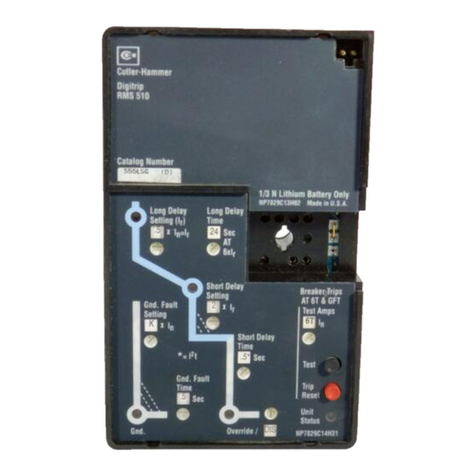
4 I.L. 4A35310B
____________________________________________________________________________________________
March 1999
• The ground swi ch canno be opened elec rically in less han 20 seconds af er closing, See Appendix D. This
fea ure permi s he source in errup er o clear a faul if he grounding swi ch is inadver en ly closed on an
energized circui as THIS DEVICE HAS NO INTERRUPTING CAPABILITY.
• The con rol swi ch cable is connec ed o he device wi h a wis lock connec or.
2.3 CON EDISON INTERLOCKS - BASIC ELEMENTS DESCRIPTION
Key Lock K1 (Keys KU & KB) - The K1 in erlock is a wo cylinder lock used o elec rically enable
or disable he G & T device.
In he Cu ler-Hammer Wes inghouse Produc s E.O. G & T device design, he K1 lock is a wo cylinder
ransfer lock wi h a swi ch associa ed wi h i . The swi ch is closed when Key KB is re ained. When
he swi ch is open, he G & T device is elec rically disabled and key KU is re ained, See Figure 2.3.1.
Key Lock K2 (Keys KB & KC) - The K2 in erlock is a wo cylinder lock used o mechanically lock he
G & T device "OPEN".
In he Cu ler-Hammer design, he K2 lock func ion is no needed. I is no possible for an opera or of he
G & T device o manually charge he closing springs or o manually close he device o ground. Therefore,
he K2 lock will be a wo cylinder ransfer key lock for consis ency wi h he Con Ed opera ing procedure,
see Figure 2.3.2.
Key Lock K3 (Key KC) - The K3 in erlock is a single cylinder lock ha when locked, preven s he G & T
device from inser ion in o he breaker compar men .
In he Cu ler-Hammer design, he K3 lock blocks he G & T device levering la ch from engaging he
levering nu in he breaker compar men . In addi ion, he K3 lock is used o preven opera ion of he
levering in screw in bo h he Tes and Connec ed posi ions. Key KC is removable wi h he lock bol
ex ended and he key normally resides in Key Lock K2, see Figure 2.3.3.
Key Lock K4 (Keys KB & KD) - The K4 in erlock is a wo cylinder lock used o mechanically lock he
G & T device in he "CLOSED" posi ion.
In he Cu ler-Hammer design, he K4 in erlock is a wo cylinder lock used wi h he "Closed Locking
Device" o preven he G & T device from being opened. When he G & T device is in he "OPEN"
s a e, he "Closed Locking Device" is disabled. Key KD is re ained when he lock bol is re rac ed. When
he G & T device is "CLOSED", he "Closed Locking Device" is free o move o he righ . The lock
bol can now be ex ended and he "Closed Locking Device" will be held in he secured "CLOSED"
posi ion. Key KD is now removable from lock K4. In his secured posi ion, he "Closed Locking Device"
has blocked opera or access o he manual "OPEN" push-bu on. Also, in his secured posi ion a
posi ion, in erlock swi ch elec rically disables he remo e "OPEN" push-bu on. A padlock hasp is
provided for securing he "CLOSED" posi ion wi h a padlock, See Figure 2.3.4..
Key Lock K5 (Key KD) - The K5 in erlock is a single cylinder lock used o open and lock he es por
shu ers.
In he Cu ler-Hammer design, he K5 in erlock is a single cylinder lock. Key KD is removable when
he lock bol is ex ended and he key normally resides in key lock K4. Key KD is available only when he
G & T device is locked "CLOSED". Key KD is removable from he K5 in erlock in wo ex ended bol
posi ions. One posi ion is when he Tes Por shu ers are closed. The second posi ion is when he Tes
Probes are inser ed in he Tes Por s and hey are being re ained by he "de en " posi ion of he shu er,
See Figure 2.3.5.





























